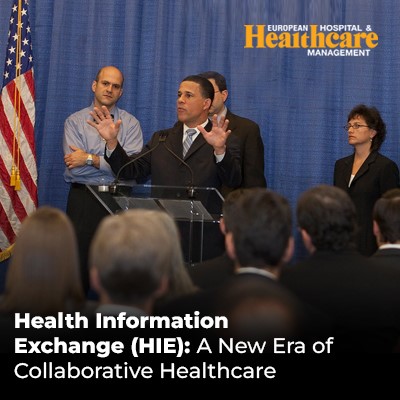Health Information Exchange (HIE) facilitates seamless sharing of patient data among healthcare providers, enhancing care coordination and efficiency. Despite challenges like privacy and interoperability, HIE's future appears promising with advancements in AI, blockchain, and telehealth integration, promising a transformative shift in collaborative healthcare delivery.

In today's fast-paced world, the healthcare industry constantly seeks ways to improve patient care and streamline processes. One of the most significant advancements in recent years is the Health Information Exchange (HIE). HIE represents a new era of collaborative healthcare, enabling the seamless sharing of patient information across different healthcare providers. This article explores the concept of HIE, its benefits, challenges, and future prospects in an easy-to-understand manner.
Health Information Exchange (HIE) is the electronic sharing of health-related information among different healthcare organizations. This exchange can occur between hospitals, doctors' offices, pharmacies, and other healthcare entities. The primary goal of HIE is to ensure that healthcare providers have access to accurate and up-to-date patient information, regardless of where the patient receives care.
a. Directed Exchange: This involves the secure transfer of patient information between healthcare providers, such as sending referrals or lab results. It's like sending an email but with strict security measures to protect patient data.
b. Query-Based Exchange: This allows healthcare providers to search for and request information about a patient from other providers. For example, if a patient visits a new doctor, the doctor can use query-based exchange to access the patient's medical history from previous providers.
c. Consumer-Mediated Exchange: This empowers patients to control their health information. Patients can manage and share their health data with healthcare providers as needed. Think of it as having your medical records on a secure app that you can share with doctors as required.
Improved Patient Care: HIE ensures that healthcare providers have comprehensive and accurate patient information, leading to better diagnosis and treatment. For instance, if a patient has an allergy to a medication, all healthcare providers can see this information and avoid prescribing that medication.
Reduced Healthcare Costs: By having access to complete patient records, healthcare providers can avoid duplicate tests and procedures, saving both time and money. This leads to more efficient use of resources.
Enhanced Patient Safety: HIE reduces the risk of medical errors by providing healthcare providers with timely access to patient information. For example, in an emergency, doctors can quickly access a patient's medical history, including any chronic conditions or current medications.
Increased Efficiency: HIE streamlines administrative processes, reducing paperwork and allowing healthcare providers to focus more on patient care. This improves overall workflow and reduces the burden on healthcare staff.
Better Public Health Reporting: HIE enables faster and more accurate reporting of public health data, which is crucial for monitoring and controlling disease outbreaks. This helps in making informed decisions and implementing timely interventions.
Privacy and Security: Protecting patient data is a top priority. Ensuring that HIE systems are secure and comply with privacy regulations, such as HIPAA (Health Insurance Portability and Accountability Act), is crucial. Data breaches and unauthorized access can have severe consequences.
Interoperability: Different healthcare organizations often use various electronic health record (EHR) systems. Ensuring that these systems can communicate and exchange information effectively is a significant challenge. Standardizing data formats and protocols is essential for seamless exchange.
Data Accuracy and Completeness: For HIE to be effective, the data shared must be accurate and complete. Inconsistent or outdated information can lead to incorrect diagnoses and treatment plans. Regular updating and verification of data are necessary to maintain accuracy.
Cost and Implementation: Implementing HIE systems can be expensive, particularly for smaller healthcare providers. There are costs associated with technology, training, and ongoing maintenance. Finding funding and resources can be a barrier to widespread adoption.
Resistance to Change: Some healthcare providers may be resistant to adopting HIE due to concerns about workflow disruption or uncertainty about the benefits. Overcoming this resistance requires education and demonstrating the tangible advantages of HIE.
The future of HIE looks promising, with ongoing advancements and innovations set to enhance its capabilities further:
Artificial Intelligence (AI) and Machine Learning: Integrating AI and machine learning into HIE systems can help analyze large volumes of data, identify patterns, and predict health trends. This can lead to more personalized and proactive patient care.
Blockchain Technology: Blockchain offers a secure and transparent way to manage health information. Its decentralized nature ensures that patient data is tamper-proof and accessible only to authorized individuals.
Telehealth Integration: The rise of telehealth has highlighted the importance of seamless information exchange. Integrating HIE with telehealth platforms can provide healthcare providers with real-time access to patient data during virtual consultations.
Patient Engagement Tools: Developing user-friendly tools and apps that allow patients to manage and share their health information easily will empower individuals to take control of their health and improve communication with healthcare providers.
Regulatory Support and Standards: Continued efforts to develop and enforce standards for data exchange and interoperability will be crucial. Government initiatives and policies can drive the widespread adoption and implementation of HIE systems.
Health Information Exchange (HIE) represents a significant step towards a more collaborative and efficient healthcare system. By enabling the seamless sharing of patient information, HIE improves patient care, reduces costs, and enhances patient safety. While there are challenges to overcome, the future of HIE is bright, with technological advancements and increased focus on interoperability paving the way for a new era of collaborative healthcare. As HIE continues to evolve, it holds the promise of transforming how healthcare is delivered and experienced by patients and providers alike.